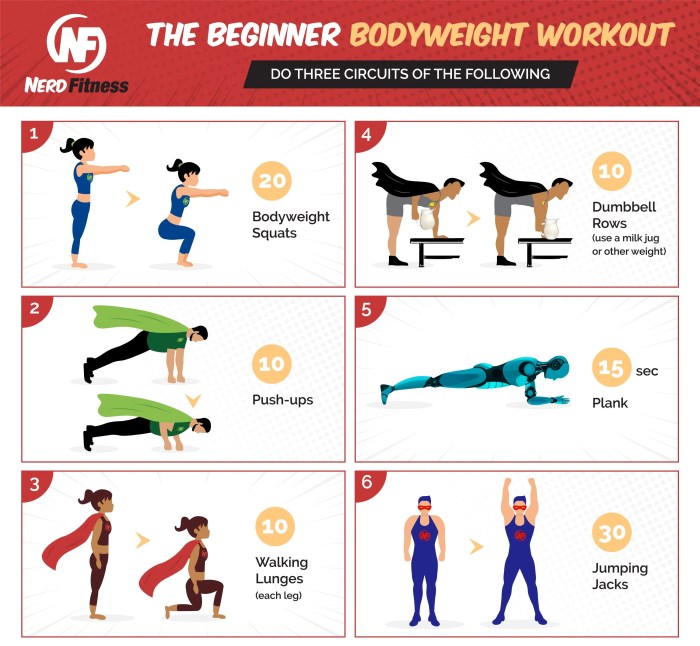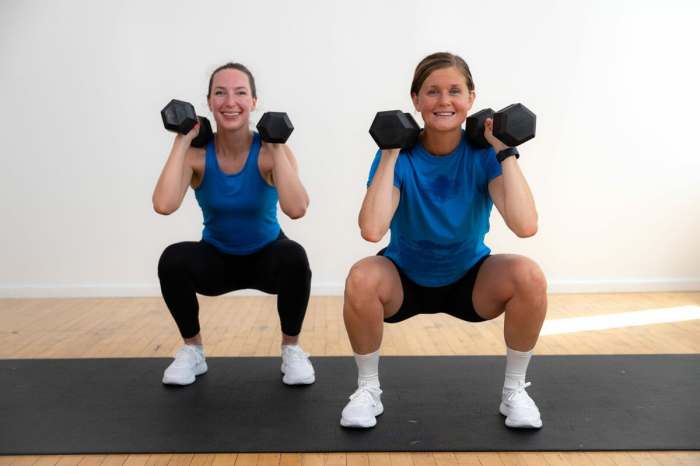Weight training workouts for women are gaining immense popularity, and for good reason. Not only do they build strength and muscle, but they also offer a plethora of benefits that extend beyond the gym, empowering women to lead healthier and more fulfilling lives.
Embark on this journey with us as we delve into the world of weight training, exploring its benefits, providing exercise recommendations, and offering guidance to help you achieve your fitness goals.
From beginners to experienced lifters, weight training has something to offer everyone. It improves bone density, reduces the risk of chronic diseases, boosts metabolism, and enhances mood. Join us as we unlock the transformative power of weight training, empowering women to embrace their strength and unlock their full potential.
Workout Structure
Designing an effective workout plan tailored to women’s unique needs is crucial. Consider factors like hormonal changes, body composition, and fitness goals. Prioritize rest and recovery, ensuring adequate sleep, nutrition, and active recovery techniques. Adjust workout intensity and duration based on menstrual cycle phases.
Stay motivated by setting realistic goals, finding a supportive community, and addressing common challenges faced by women in fitness.
Sample Workout Plans
- Beginner:Focus on compound exercises like squats, lunges, and push-ups. Start with 2-3 sets of 10-12 repetitions, 2-3 times per week.
- Intermediate:Include more isolation exercises and increase weight or resistance. Aim for 3-4 sets of 8-12 repetitions, 3-4 times per week.
- Advanced:Incorporate advanced techniques like supersets, drop sets, and periodization. Train 4-5 times per week, with a mix of heavy and light days.
Rest and Recovery
Rest and recovery are essential for muscle growth and repair. Aim for 7-9 hours of sleep per night, and prioritize a balanced diet rich in protein, carbohydrates, and healthy fats.
Menstrual Cycle Considerations
- Follicular Phase (Days 1-14):Energy levels are typically high, making it a good time for intense workouts.
- Ovulation Phase (Days 14-16):Hormonal changes may increase body temperature and heart rate, so adjust workout intensity accordingly.
- Luteal Phase (Days 16-28):Progesterone levels rise, which can lead to fatigue and water retention. Focus on lighter workouts or active recovery.
Staying Motivated
- Set realistic goals and track your progress.
- Find a supportive community or workout buddy.
- Address common challenges like body image issues and lack of time.
Male vs. Female Workout Considerations
| Factor | Male | Female |
|---|---|---|
| Body Composition | Typically higher muscle mass, lower body fat | Typically lower muscle mass, higher body fat |
| Hormonal Profile | Testosterone promotes muscle growth | Estrogen and progesterone influence body composition |
| Fitness Goals | Often prioritize muscle building | May prioritize weight loss, body shaping, or overall fitness |
Nutrition for Weight Training

Proper nutrition is crucial for women engaging in weight training. It provides the body with the necessary energy and nutrients to support muscle growth, recovery, and overall health. This section will delve into the nutritional requirements, meal plans, and supplement recommendations for women involved in weight training.
Weight training increases the body’s demand for calories, protein, carbohydrates, and healthy fats. A balanced diet that meets these increased demands is essential for optimal results.
Macronutrient Requirements
The macronutrient composition of a diet for weight training should prioritize the following:
- Protein:1.6-2.2 grams per kilogram of body weight daily. Protein is essential for muscle growth and repair.
- Carbohydrates:4-6 grams per kilogram of body weight daily. Carbohydrates provide energy for workouts and support recovery.
- Fat:1-1.2 grams per kilogram of body weight daily. Healthy fats support hormone production and cell function.
Meal Plans
Meal plans should be tailored to individual calorie needs and training intensity. Here’s a sample meal plan for a woman weighing 60 kilograms (132 pounds) engaged in moderate-intensity weight training:
- Breakfast:Oatmeal with berries, nuts, and protein powder
- Lunch:Grilled chicken salad with mixed greens, vegetables, and quinoa
- Snack:Greek yogurt with fruit and granola
- Dinner:Salmon with roasted vegetables and brown rice
- Snack:Casein protein shake before bed
Supplement Recommendations
Supplements can enhance the effectiveness of a weight training program, but they should be used in conjunction with a balanced diet.
- Creatine:Improves muscle strength and power.
- BCAAs:Essential amino acids that support muscle growth and recovery.
- Glutamine:Supports muscle recovery and reduces muscle soreness.
Safety and Technique

Weight training is a great way to get in shape and improve your overall health. However, it’s important to follow proper form and technique to avoid injuries. Here are a few tips to help you stay safe while weight training:
Warm Up
Always warm up before lifting weights. This will help to prepare your body for the workout and reduce your risk of injury.
Use Proper Form
It’s important to use proper form when lifting weights. This means using the correct range of motion and engaging the correct muscles. Using improper form can put you at risk for injury.
Don’t Lift Too Heavy, Weight training workouts for women
Start with a weight that is challenging but not too heavy. As you get stronger, you can gradually increase the weight.
Listen to Your Body
If you feel any pain, stop lifting and consult with a doctor. Pushing through pain can lead to serious injury.
Cool Down
After your workout, cool down by stretching. This will help to reduce muscle soreness and improve flexibility.
Common Exercises and Their Proper Form and Technique
Here is a table with common exercises and their corresponding proper form and technique:
| Exercise | Proper Form and Technique |
|---|---|
| Squat | Stand with your feet shoulder-width apart. Bend your knees and lower your body until your thighs are parallel to the floor. Keep your back straight and your chest up. Push back up to the starting position. |
| Bench Press | Lie on a bench with your feet flat on the floor. Grip the barbell with your hands shoulder-width apart. Lower the barbell to your chest and then press it back up to the starting position. |
| Deadlift | Stand with your feet hip-width apart. Bend your knees and lower your body until you can grasp the barbell with your hands shoulder-width apart. Keep your back straight and your chest up. Lift the barbell up to your waist and then lower it back down to the starting position. |
“Proper form is essential for weight training. It can help you avoid injuries and get the most out of your workouts.”– American Council on Exercise
Tracking Progress

Keeping track of your weight training progress is crucial for staying motivated and making necessary adjustments. Setting realistic goals will help you avoid discouragement and keep you on track.
Monitoring Results
- Weight lifted:Record the weight you lift for each exercise and track any increases over time.
- Sets and repetitions:Note the number of sets and repetitions you complete for each exercise.
- Body measurements:Take measurements of your body circumference, such as chest, waist, and thighs, to monitor changes in muscle mass and body fat.
- Strength tests:Perform regular strength tests, such as the bench press or squat, to assess your strength gains.
- Progress photos:Take progress photos every few weeks to visually track changes in your physique.
Motivation and Mindset
Maintaining motivation and a positive mindset is crucial for success in weight training. Here are strategies to help you stay on track and overcome challenges.
Setting Goals
Setting clear, achievable goals provides a sense of purpose and direction. Break down your goals into smaller, manageable steps to make them less daunting. Track your progress and celebrate your successes, no matter how small.
Tip:Use the SMART goal-setting framework (Specific, Measurable, Achievable, Relevant, Time-bound) to ensure your goals are effective.
Overcoming Challenges
Obstacles are inevitable, but it’s how you respond to them that matters. Embrace challenges as opportunities for growth. When faced with setbacks, remind yourself of your goals and why you started. Don’t be afraid to ask for help or support from friends, family, or a trainer.
Quote:“The greatest glory in living lies not in never falling, but in rising every time we fall.” – Nelson Mandela
Developing a Positive Mindset
A positive mindset is essential for staying motivated. Focus on your strengths, progress, and the benefits of weight training. Surround yourself with supportive people who believe in you. Practice gratitude for your body and its abilities.
Tip:Start each day with affirmations or positive self-talk to boost your confidence and mindset.
Success Stories
Testimonials and success stories from others can inspire and motivate you. Here’s an example:
Testimonial:“I never thought I could lift weights, but after joining a weight training program, I’ve gained strength, confidence, and a sense of accomplishment.” – Sarah, a weightlifter
Equipment and Resources

Weight training requires various equipment to target different muscle groups and perform exercises effectively. Understanding the benefits and drawbacks of each type of equipment can help you make informed choices based on your fitness level, goals, and budget.
Essential Equipment
- Barbells:Long, weighted bars used for compound exercises like squats, deadlifts, and bench presses. They allow for heavy weightlifting and progressive overload.
- Dumbbells:Free weights in pairs, available in various weights. They enable isolation exercises, unilateral movements, and a wider range of motion.
- Kettlebells:Ball-shaped weights with a handle, ideal for dynamic exercises like swings, snatches, and cleans. They promote core engagement and cardiovascular fitness.
- Resistance Bands:Elastic bands that provide resistance without weights. They are portable, versatile, and suitable for beginners or rehab.
Choosing the Right Equipment
Consider the following factors when selecting equipment:
- Fitness Level:Start with lighter weights and gradually increase resistance as you progress.
- Goals:Different equipment supports specific goals, e.g., barbells for strength, dumbbells for muscle definition.
- Budget:Equipment costs vary; consider your financial constraints and long-term goals.
Gym Etiquette and Safety
- Respect other gym members and equipment.
- Use proper form to avoid injuries.
- Warm up before workouts and cool down afterward.
- Stay hydrated and wear appropriate clothing.
- Clean equipment after use.
Online Resources
- Workout Plans:Find structured workout programs tailored to your goals and fitness level.
- Video Tutorials:Learn proper exercise form and techniques from experienced trainers.
- Forums:Connect with other weightlifters, share experiences, and get support.
Support Groups
- In-Person:Join local weightlifting clubs or classes for guidance and motivation.
- Online:Participate in online communities, forums, or social media groups dedicated to weight training.
Special Considerations
Weight training is a beneficial activity for women of all ages, but it’s important to be aware of specific considerations for different groups.
Women over 40 may experience decreased muscle mass and bone density. To address this, focus on compound exercises that work multiple muscle groups and incorporate weight-bearing exercises like squats and lunges. Consider adding resistance bands or weights to increase the challenge.
Pregnant Women
During pregnancy, it’s essential to consult a healthcare professional before starting or continuing a weight training program. In general, it’s recommended to avoid exercises that involve lying on your back or abdomen after the first trimester. Choose exercises that are safe and comfortable, such as modified squats, lunges, and arm exercises.
Individuals with Injuries
If you have any injuries, it’s crucial to seek professional guidance before engaging in weight training. A physical therapist or trainer can help you identify modifications and alternative exercises that are safe and effective for your specific condition.
| Injury | Modifications/Alternative Exercises |
|---|---|
| Knee pain | Leg press, seated calf raises, hamstring curls |
| Shoulder pain | Dumbbell rows, lateral raises, overhead press with modified range of motion |
| Back pain | Glute bridges, planks, seated rows |
“For women over 40, weight training can help preserve muscle mass, reduce the risk of osteoporosis, and improve overall health and well-being.”
American College of Sports Medicine
FAQs
Weight training for women is a great way to improve strength, lose weight, and boost confidence. However, there are a few common questions that women have about weight training.
Here are the answers to some of the most frequently asked questions about weight training for women:
Exercise Selection
| Question | Answer |
|---|---|
| What exercises should I do? | The best exercises for you will depend on your fitness level and goals. However, some good beginner exercises include squats, lunges, push-ups, and rows. |
| How often should I lift weights? | Most experts recommend lifting weights 2-3 times per week. However, you can adjust this frequency based on your fitness level and goals. |
| How many sets and reps should I do? | For beginners, it is recommended to do 2-3 sets of 8-12 repetitions of each exercise. As you get stronger, you can increase the number of sets and repetitions. |
Nutrition
| Question | Answer |
|---|---|
| What should I eat before and after a weight training workout? | Before a workout, it is important to eat a meal that is high in carbohydrates and protein. This will give you the energy you need to power through your workout. After a workout, it is important to eat a meal that is high in protein to help your muscles recover. |
| How much protein do I need? | The recommended daily intake of protein for women is 0.8 grams per kilogram of body weight. However, if you are weight training, you may need to increase your protein intake to 1.2-1.7 grams per kilogram of body weight. |
| Do I need to take supplements? | Supplements are not necessary for weight training, but they can be helpful for some people. Some popular supplements for weight training include protein powder, creatine, and beta-alanine. |
Safety
| Question | Answer |
|---|---|
| How do I avoid injury? | The best way to avoid injury is to use proper form when lifting weights. It is also important to warm up before your workout and cool down afterwards. |
| What are some common injuries? | Some common injuries in weight training include muscle strains, sprains, and tears. These injuries can be caused by using improper form, lifting too much weight, or not warming up properly. |
| What should I do if I get injured? | If you get injured, it is important to stop exercising and see a doctor. |
Conclusion
Weight training empowers women, leading them towards a path of self-discovery and well-being. It enhances physical and mental strength, boosting confidence and resilience. By embracing the transformative power of weights, women unlock a world of possibilities, fostering a positive body image and embracing their true potential.
* Weight training empowers women, boosting their self-confidence and resilience.
- It promotes a positive body image, helping women appreciate their bodies for their strength and capabilities.
- By challenging themselves with weights, women unlock a sense of accomplishment and personal growth.
Additional Resources

To enhance your weight training journey, we’ve compiled a comprehensive collection of resources to support your progress.
Explore reputable sources, research studies, and support groups to deepen your understanding and stay connected with the fitness community.
Links to Reputable Sources
- National Strength and Conditioning Association (NSCA): https://www.nsca.com
- American Council on Exercise (ACE): https://www.acefitness.org
- Mayo Clinic: https://www.mayoclinic.org/healthy-lifestyle/womens-health/in-depth/womens-fitness/art-20045256
Research Studies
- Effect of Resistance Training on Body Composition and Strength in Women: https://www.ncbi.nlm.nih.gov/pmc/articles/PMC6688706/
- The Role of Resistance Training in Weight Management: https://www.ncbi.nlm.nih.gov/pmc/articles/PMC6016609/
Support Groups
- Women’s Strength Training Network: https://www.facebook.com/groups/WomensStrengthTrainingNetwork
- Women’s Fitness Forum: https://www.bodybuilding.com/boards/womens-fitness-forum
Ending Remarks: Weight Training Workouts For Women
Incorporating weight training into your fitness routine is a transformative decision that will empower you on your journey toward a healthier and more vibrant life. Embrace the challenge, enjoy the process, and witness the remarkable changes that weight training brings to your physical and mental well-being.
Remember, the journey of a thousand miles begins with a single step. Take that step today and embark on a path of strength, empowerment, and well-being.
General Inquiries
What are the benefits of weight training for women?
Weight training offers numerous benefits for women, including increased strength and muscle mass, improved bone density, reduced risk of chronic diseases, boosted metabolism, and enhanced mood.
How do I get started with weight training?
Start by finding a qualified trainer or joining a beginner-friendly weight training class. Choose exercises that target different muscle groups and focus on proper form to prevent injuries.
How often should I do weight training?
Aim for 2-3 weight training sessions per week, with rest days in between. Listen to your body and adjust the intensity and duration of your workouts accordingly.
What exercises are best for women?
Effective exercises for women include squats, lunges, push-ups, rows, and overhead presses. These exercises target major muscle groups and promote overall strength development.
How do I progress my weight training workouts?
Gradually increase the weight, sets, repetitions, or exercise difficulty over time. Challenge yourself while maintaining proper form and technique to maximize results.
Leave a Reply